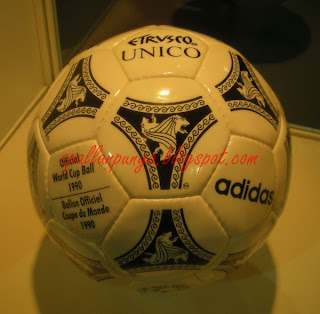Disamping mempamirkan trofi Piala Dunia, dipamirkan juga bolasepak-bolasepak rasmi yang telah digunakan pada perlawanan Piala Dunia yang lepas-lepas. Disini aku post kesemua bolasepak yang dipamirkan kat FIFA World Cup Trophy Tour. (sumber maklumat dari FIFA World Cup Trophy Tour by Coca Cola)
*
Telstar: Mexico
Adidas started to make soccer balls in 1963 but made the first official FIFA World Cup ball in 1970. The first ball used in the World Cup with Buckminster type of design. The first ball with 32 black and white panels. The TELSTAR was more visible on black and white televisions (1970 World Cup Mexico
*
Telstar Durlast R: West Germany
The TELSTAR was again used. Another version was the Chile Durlast ball which did not have the black panels.
Tango Durlast: Argentina
The ball design represented elegance, dynamism and passion.
Tango Espana: Spain, 1982
Adidas introduced a new ball which rubber inlaid over the seams to prevent water from seeping through. The first ball with water-resistant qualities. General wear from kicking however meant the rubber began to wear after a short time and needed to be replaced during the game.
The last genuine leather World Cup Ball.
Azteca: Mexico
The FIFA World Cup Mexico
Etrvsco: Italy, 1990
The first ball with an internal layer of black polyurethane foam.

Questra:
FIFA World Cup

Tricolore:
By 1998, FIFA World Cup

Fevernova: Korea/Japan, 2002
For FIFA World Cup Korea/Japan, 2002, Adidas created a new ball made up of thicker inner layers to increase the accuracy of the ball in flight.

Temgeist
The revolutionary ball was designed to minimise corners and create a more homogeneous system. The new 14-panel design provides consistent performance and with fewer seams, it travels more uniformly, no matter where it is hit.

Jabulani:
JABULANI, meaning "to celebrate" is the 11th Adidas World Cup ball. The match ball for the 2010 FIFA World Cup features a completely new, ground-breaking technology. JABULANI has a futuristic texture with fantastic grip, giving players full control over the ball under all weather conditions. It also has eight, completely new thermally bonded 3-D panels, which for the first time are spherically molded, the ball is perfectly round and even more accurate than before.








No comments:
Post a Comment